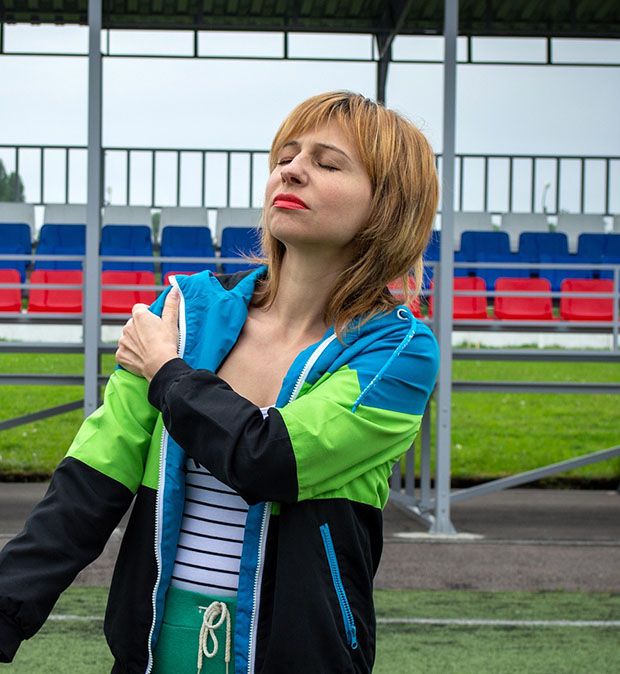What Are The Causes Of Shoulder Pain?

Shoulder pain is a common complaint in our wimbledon based physio clinic. With shoulder pain affecting millions of people world wide not just in wimbledon. Various factors effects shoulder pain, including injury, overuse, arthritis, and other medical conditions, can cause it.
In this article, we will look at the most common causes of shoulder pain and the research conducted to understand these conditions better. While
We also talk to our perspective of treating the subsets of shoulder pain in Wimbledon Clinic physio which you will get after diagnosis. We also have made effort to give indicators to how ultrasound or focused shock wave therapy done by physio in wimbledon clinic may work for some of the more common types of shoulder pain.
Rotator Cuff Injuries:
A rotator cuff is a collection of 5 muscles and tendons that surround the shoulder, ball and socket joint, providing support and allowing the shoulder to move.
Injuries to the rotator cuff are a common cause of shoulder pain, particularly among athletes and people who engage in repetitive overhead movements.
According to a study seen in the Journal of Shoulder and Elbow Surgery in 2015, rotator cuff tears are present in up to 20% of people over the age of 60, and this number increases with age.
Shoulder Impingement:
Shoulder impingement occurs when the rotator cuff muscles are pinched between the shoulder blade and the upper arm bone, and this can cause pain and inflammation in the shoulder joint. A study published in the Journal of Orthopaedic and Sports Physical Therapy in 2018 found that shoulder impingement is common among overhead athletes, with up to 85% of swimmers and 75% of baseball pitchers experiencing symptoms.
Frozen Shoulder:
Frozen shoulder, known as 'adhesive capsulitis', is a diagnosis in which the shoulder joint becomes stiff and painful, making it difficult to move. The exact trigger of a frozen shoulder is unknown, but it is more common in people with diabetes and other medical conditions. A published study in the Journal of Shoulder and Elbow Surgery in 2017 found that patients with frozen shoulders had significantly higher levels of inflammatory markers in their blood compared to healthy individuals.
Arthritis:
Arthritis is a diagnosis that causes inflammation in the joints, including the shoulder joint. Several types of arthritis can affect the shoulder, including osteoarthritis, rheumatoid arthritis, and psoriatic arthritis. A study published in the Journal of Rheumatology in 2015 found that shoulder arthritis was present in up to 39% of patients with rheumatoid arthritis.
Bursitis:
Bursitis is a condition in which the fluid-filled sacs (bursae) that cushion the joints become inflamed. This inflammation can cause pain and stiffness in the affected joint, including the shoulder. According to a published study in the Journal of Shoulder and Elbow Surgery in 2014, subacromial bursitis is a common cause of shoulder pain, particularly among middle-aged adults.
In conclusion, shoulder pain can have a variety of causes, including rotator cuff injuries, shoulder impingement, frozen shoulder, arthritis, and bursitis. Understanding the underlying cause of shoulder pain is essential for proper diagnosis and treatment. If you are experiencing shoulder pain, seeking a Physiotherapist's attention is vital to determine the cause and develop an appropriate treatment plan.
If you haven't been diagnosed as to what part of your shoulder is generating your pain, then you need a diagnosis first. This is essential, and your physio should always confirm your working diagnosis. Shoulder pain is not a diagnosis, and neither is rotator cuff diagnosis. You should expect the exact muscle/ tendon involved or at least the primary pain generator.


What Treatments May Work For My Shoulder Pain?
Rotator cuff injuries, shoulder impingement, frozen shoulder, arthritis, and bursitis can all be treated with various physiotherapy interventions, including ultrasound therapy and shockwave therapy. This next section will explore the evidence behind these treatments and their effectiveness in treating these shoulder conditions.
Rotator Cuff Injuries:
Rotator cuff injuries can be treated with various physiotherapy interventions, including exercise therapy, manual therapy, and modalities such as ultrasound therapy and shockwave therapy. A review published in the Journal of Orthopaedic & Sports Physical Therapy in 2015 found that exercise therapy effectively reduced pain and improved function in patients with rotator cuff injuries. However, the evidence for ultrasound therapy was inconclusive, with some studies showing a positive effect and others showing no significant benefit. However more studies have indicated the use of focused shock wave therapy for tendinopathy of the rotator cuff (specifically calcified types of rotator cuff tendon pain).
Shoulder Impingement:
Shoulder impingement can also be treated with exercise, manual, ultrasound, and shockwave therapy. A review published in the Journal of Orthopaedic & Sports Physical Therapy in 2018 found that exercise therapy effectively reduced pain and improved function in patients with shoulder impingement. This would also back up what we have seen within our clinic in Wimbledon where we treat impingement syndrome with great success within this shoulder pain diagnosis. In truth the only time these therapies don't work for shoulder impingement is where the client hasn’t been able to make lifestyle changes needed for recovery or the is a genetically large acromion (the roof of the joint), which can be investigated on x-ray or MRI.
The last group of non responders is ones with large tears in the rotator cuff. These are typically classed as above 50% and can be seen on MRI (gold standard investigation), if you have had traditional therapy that hasn't worked at another clinic get in contact with us as we can refer you to a 3T MRI which is extremely accurate modern MRI unit to establish whether your results are down to treatment factors or a underlying issue with the bone or tendon structure. But it's likely if you can't remember a traumatic cause, objective damage may be less likely and if you haven't tried physio in wimbledon clinic then we can probably help your impingement syndrome.
Frozen Shoulder:
Frozen shoulder is treated with various physiotherapy interventions, including exercise therapy, manual therapy, and modalities such as ultrasound therapy and shockwave therapy. A review published in the Journal of Shoulder and Elbow Surgery in 2017 found that exercise therapy effectively reduced pain and improved function in patients with frozen shoulders. When we treat frozen shoulders at Wimbledon clinic we notice that these intervention options speed up recovery over clients that opt for just wait-it-out approaches. One really helpful remedy here is good 3T MRI (or better) to assess the capsule for confirmation of adhesion of the shoulder capsule, this often gives the confidence to move through discomfort. Particularly as frozen shoulder can often mimic a number of other should pain syndromes like impingement syndrome or calcific tendonitis.
Shoulder Arthritis:
Arthritis can be treated with various physiotherapy interventions, including exercise therapy, manual therapy, and modalities such as ultrasound therapy and shockwave therapy.
A systematic review published in the Journal of Hand Therapy in 2018 found that exercise therapy effectively reduced pain and improved function in patients with shoulder arthritis.
The evidence for manual therapy, ultrasound therapy, and shockwave therapy was inconclusive, with some studies showing no significant benefit but others showing a positive effect.
Often the effectiveness will come down to whether the arthritis is a stable or unstable type which requires diagnosis.
Shoulder Bursitis:
Bursitis can also be treated with various physiotherapy interventions, including exercise therapy, manual therapy, and modalities such as ultrasound therapy. A review published in the Journal of Shoulder and Elbow Surgery in 2016 found that exercise therapy was effective in reducing pain and improving function in patients with shoulder bursitis.
As with most therapies; your individual presentation or severity may make therapy like shock wave therapy or ultrasound less or more likely to work which makes consultation essential.

Shoulder pain management in wimbledon - conclusions
In conclusion, physiotherapy interventions, including exercise therapy, manual therapy, ultrasound therapy, and shockwave therapy, can effectively treat rotator cuff injuries, shoulder impingement, frozen shoulder, arthritis, and bursitis.
However, the evidence for modalities such as ultrasound therapy and shockwave therapy will vary depending on subtype of shoulder pain.
Therefore, it is crucial to seek the advice of a qualified healthcare professional to determine the most appropriate treatment plan for your specific shoulder condition.
For instance, shock wave therapy will work well in calcific tendonitis or the shoulder's rotator cuff and for tendinopathy of the rotator cuff but not so much for rotator cuff muscle weakness.
With this in mind, we typically triage your specific presentation and add ultrasound or shock wave therapy on top of traditional care to produce better outcomes, as no study has associated these added care interventions with negatives.
This approach can only be positive but should always be led by one of our Wimbledon-based physiotherapists.
If you would like us to look at your shoulder pain condition through one of our Wimbledon-based physiotherapists at Wimbledon Clinic.
Please click on Contact Us button below
References:
- Yamamoto, A., Takagishi, K., Osawa, T., Yanagawa, T., Nakajima, D., & Shitara, H. (2015). Prevalence and risk factors of a rotator cuff tear in the general population. Journal of Shoulder and Elbow Surgery, 24(5), 1585-1593.
- Hegedus, E. J., Goode, A., Campbell, S., Morin, A., Tamaddoni, M., & Moorman, C. T. (2018). Physical examination tests of the shoulder: a systematic review with meta-analysis of individual tests. Journal of Orthopaedic & Sports Physical Therapy, 48(9), 756-771.
- Muh, S. H., Kim, S. H., Lee, S. Y., & Jeong, J. H. (2017). Comparison of serum inflammatory cytokines according to clinical stages of frozen shoulder. Journal of Shoulder and Elbow Surgery, 26(6), 1029-1034.
- Palazzo, C., Nguyen, C., Lefevre-Colau, M. M., Rannou, F., Poiraudeau, S., & Revel, M. (2015). Prevalence of symptomatic shoulder osteoarthritis in patients with rheumatoid arthritis. The Journal of Rheumatology, 42(9), 1637-1643.
- Ranebo, M. C., Bjornsson Hallgren, H. C., & Norlin, R. (2014). Subacromial bursitis: a common finding in occupationally active middle-aged men. Journal of Shoulder and Elbow Surgery, 23(12), 1730-1735.